Spring is the season that follows winter, typically occurring from March to June in the Northern Hemisphere and September to December in the Southern Hemisphere. Characteristics of spring include longer days, warmer temperatures, more sunshine, rain showers, and increased plant growth.
People yearn for spring flowers because they often represent a sign of hope after a long winter. Spring flowers like daffodils are often seen blooming even before the snow has melted away. Their bright colors can bring joy and optimism for brighter days ahead. Early spring flowers provide beauty around us and an array of delightful fragrances that can lift our spirits during this transitional time of year. Here are some of our favorite early spring blooms!
1. Crocus
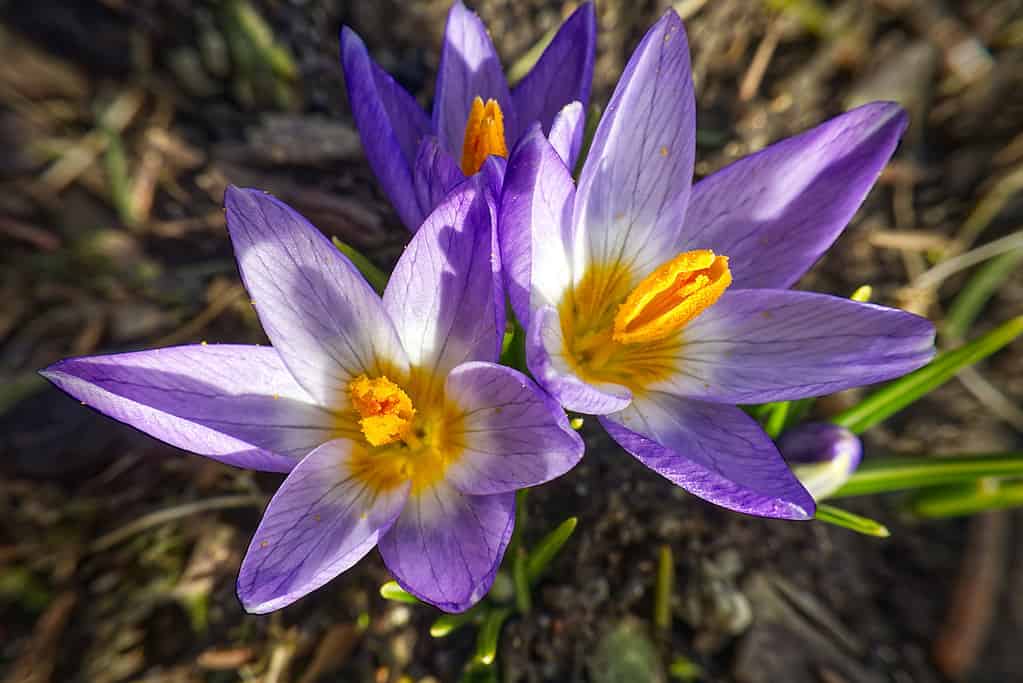
Crocuses are often planted near trees or shrubs where they will get plenty of sunlight but be sheltered from strong winds and chilly temperatures.
©iStock.com/Anna Everes
Crocus is a small, spring-blooming flower that belongs to the Iridaceae family. It typically blooms in early spring and comes in various colors, such as purple, yellow, white, and pink. The flower has six petals arranged in two circles around a central yellow or orange stigma. Each plant can have up to 20 flowers, depending on its cultivar type. Crocuses are often planted near trees or shrubs where they will get plenty of sunlight but be sheltered from strong winds and chilly temperatures. They do best when planted in well-drained soil with plenty of organic matter added for nutrients. Once established, they require very little maintenance.
2. Daffodil
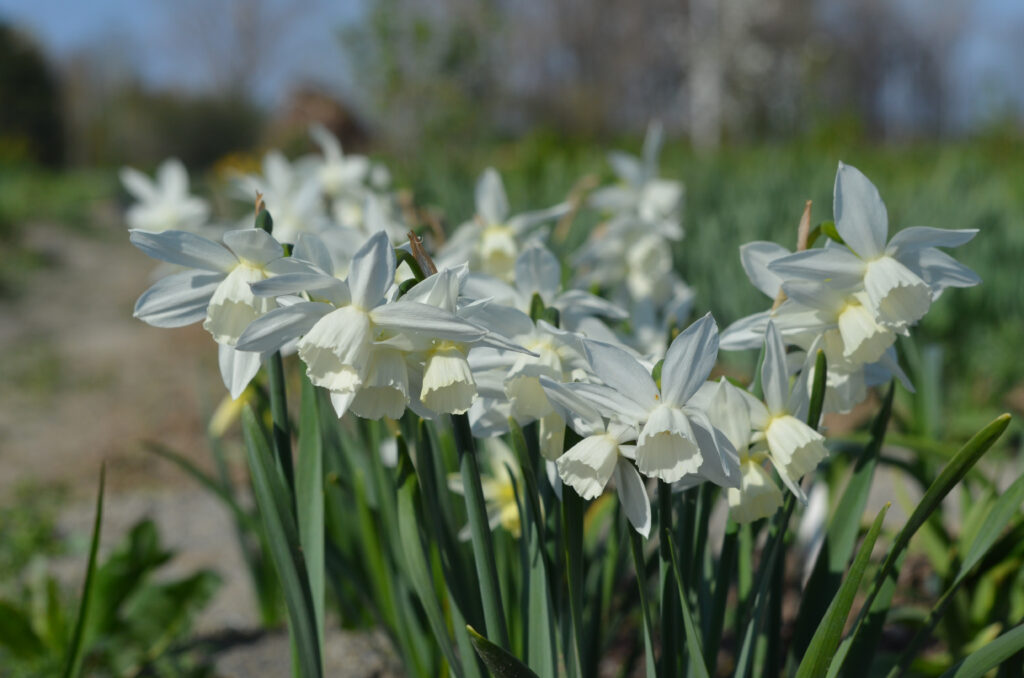
Daffodils generally bloom in early spring, although some are later varieties too.
©/Shutterstock.com
A daffodil is a perennial flowering plant of the genus Narcissus. It has been cultivated for centuries and is one of the most recognizable flowers in springtime. Daffodils generally bloom in early spring, although some are later varieties too. The traditional wildflower typically features a yellow trumpet with white petals surrounding it and a long stem for support. However, some varieties feature orange trumpets or multiple rows of ruffled petals around the center. The flower symbolizes new beginnings and hopes, making it an ideal choice for any spring bouquet!
3. Dwarf Iris
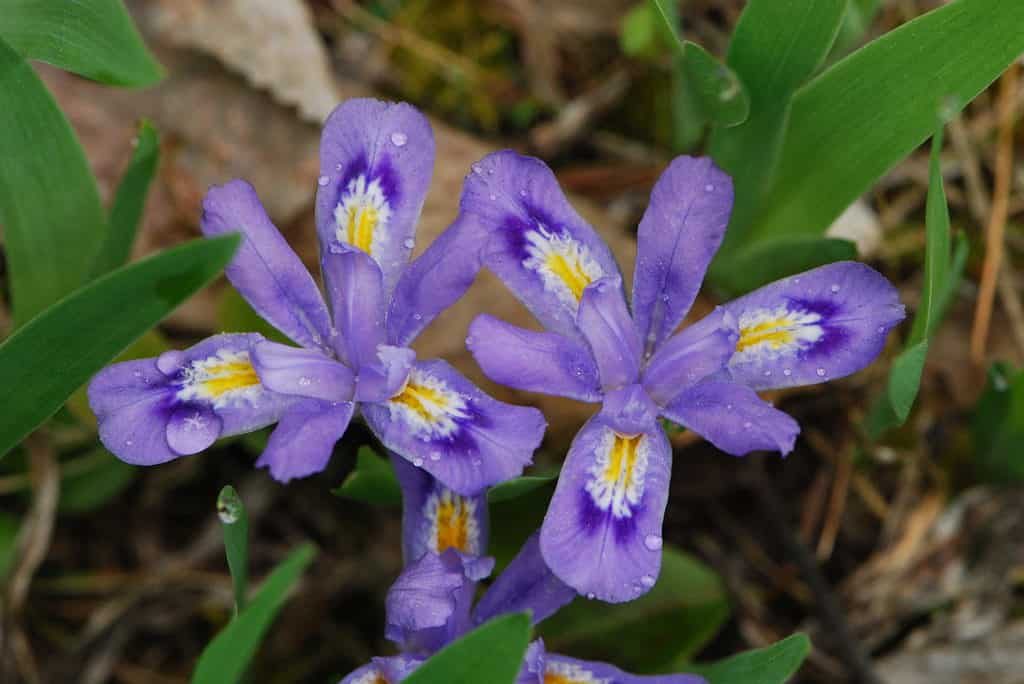
Dwarf irises are quite unique among flowers because they have slender stems with many short leaves that form a grass-like shape and flowers with six petals of purple and violet blue.
©Joshua Mayer from Madison, WI, USA, CC BY-SA 2.0 <https://creativecommons.org/licenses/by-sa/2.0>, via Wikimedia Commons – License
A dwarf iris is a small, perennial flowering plant in the genus Iris. It typically blooms in early spring, from late February to April, depending on the climate and location. Dwarf irises are quite unique among flowers because they have slender stems with many short leaves that form a grass-like shape and flowers with six petals of purple and violet blue. The center of each flower often has attractive spots or lines that add to its beauty. Dwarf irises can be found growing wild along roadsides and in gardens across Europe and North America.
4. Glory of the Snow
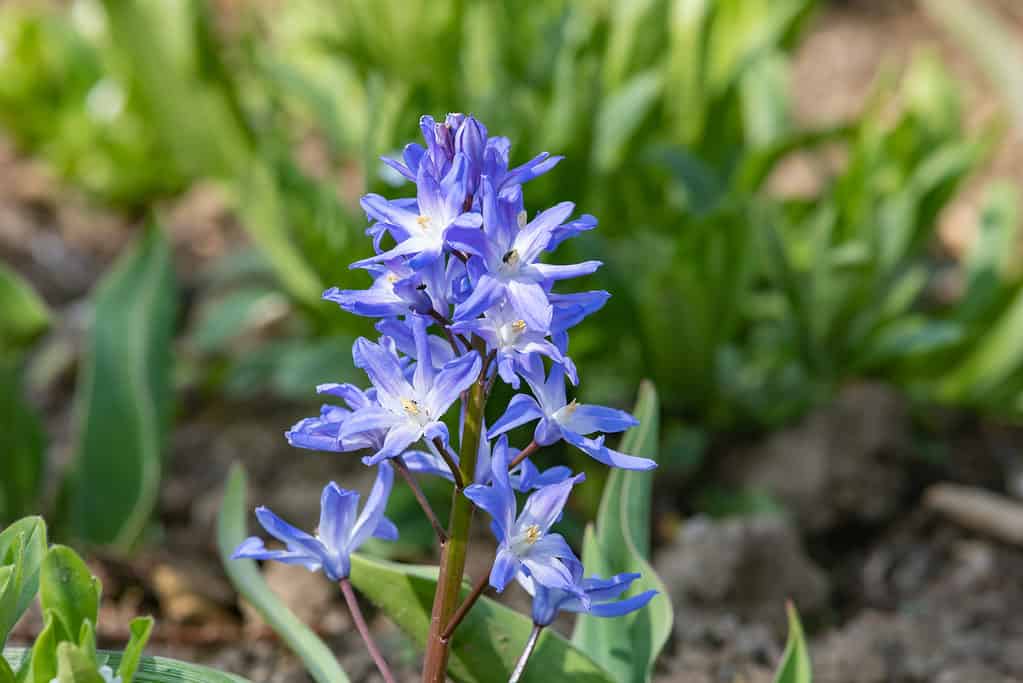
The beauty of the glory of the snow flower has made it popular with gardeners all over the world, who admire its delicate petals and unique color combination.
©iStock.com/Tom Meaker
Glory of the snow is a type of small blue flowering plant that typically blooms in early spring. It has six petals arranged around a central white eye. The flowers are quite small, only reaching about 4 cm in diameter when fully open. They are often seen growing on hillsides or amongst other low-lying vegetation, and they usually bloom for two weeks before disappearing until the following year. The beauty of the glory of the snow flower has made it popular with gardeners all over the world, who admire its delicate petals and unique color combination.
5. Grape Hyacinth

Grape hyacinths make a lovely addition to any garden and can be planted in groups or as borders around other plants for a natural look.
©Iva Vagnerova/Shutterstock.com
The grape hyacinth is a small and colorful flowering bulbous plant from the genus Muscari. It produces fragrant, bell-shaped flowers that are typically blue in color, though there are also white, yellow, and pink varieties. The blooming time for these plants can vary by region, but generally, they begin to flower in late winter or early spring. Each bloom cluster gives off an aroma reminiscent of grapes and has been known to attract butterflies and bees. The foliage is usually grassy green with pointed tips. Grape hyacinths make a lovely addition to any garden and can be planted in groups or as borders around other plants for a natural look.
6. Lily of the Valley

Often referred to as May bells or Our Lady’s tears, Lily of the Valley comes into bloom around the time of the feast day for Mary.
©Agnes Kantaruk/Shutterstock.com
A Lily of the Valley is a type of flowering plant that typically blooms in early spring. It has long, slender, blade-shaped leaves. The small white bell-shaped flowers have a distinctive sweet fragrance and can be found growing in wooded areas or as ornamental garden plants. They are often referred to as May bells or Our Lady’s tears due to their coming into bloom around the time of the feast day for Mary, Mother of Jesus, during the month of May. They are vigorous spreaders and will cover a large area in a short time.
7. Siberian Squill
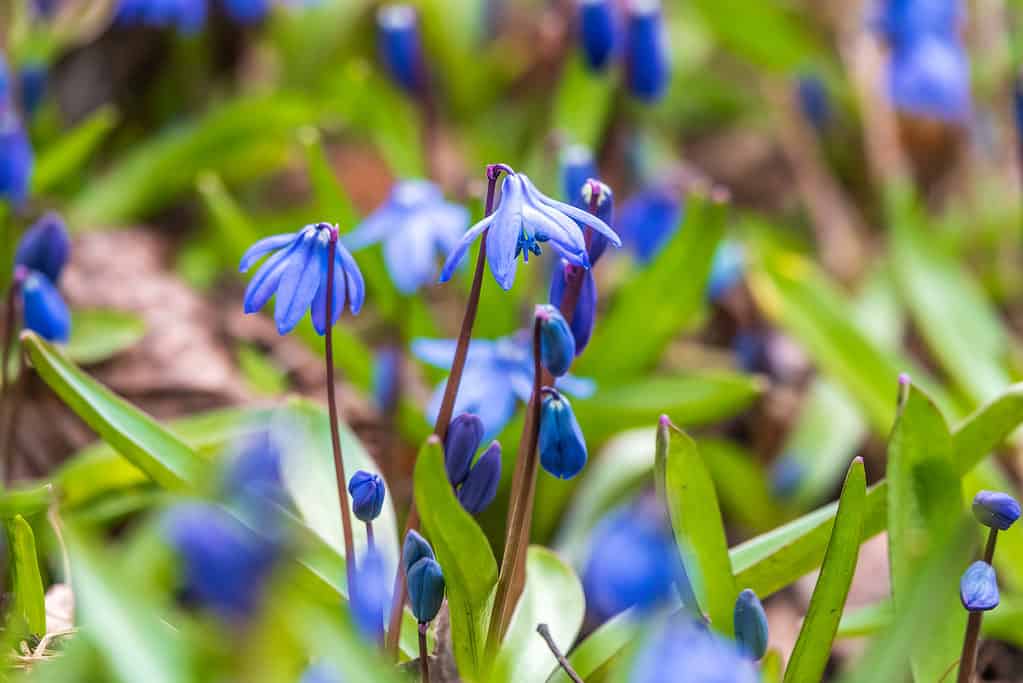
The Siberian squill
grows from bulbs
under the soil surface, usually reaching between 3-6 inches high when in bloom.
©iStock.com/Dmitry Potashkin
Siberian squill (Scilla siberica) is a species of flowering plant related to lilies, onions, and asparagus. The Siberian squill grows from bulbs under the soil surface, usually reaching between 3-6 inches high when in bloom. Its vibrant blue flowers begin to appear during early spring, generally blooming from March to April. Each flower has six petals that form a star shape, radiating outwards and slightly downwards from its central point – an eye-catching addition to any garden or outdoor space!
8. Single Early Tulip
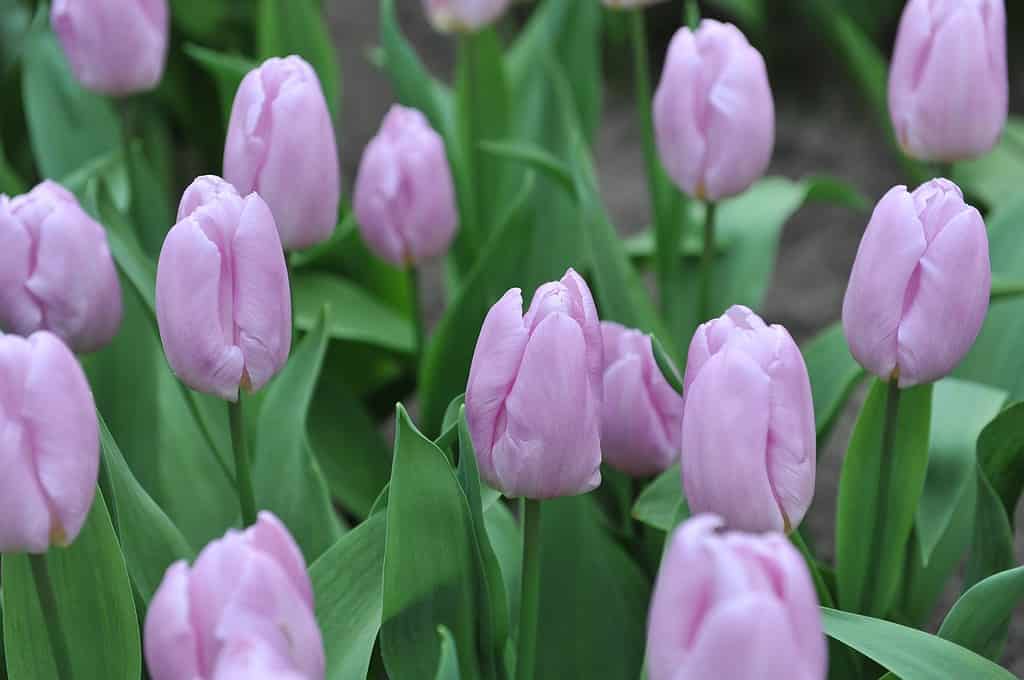
Single early tulips also have distinctive pointed leaves, which can vary greatly in color depending on their species – ranging from deep green to blue-green tones.
©Sergey V Kalyakin/Shutterstock.com
A single early tulip is a type of flower bulb that typically blooms in late March or early April. This makes it one of the first flowers to bloom during springtime. The single early tulip comes in many varieties, with some featuring multiple colors and others having solid bright hues like yellow, orange, red, and white. Depending on the variety, the stem may be short or tall and slender with a cup-shaped blossom at its tip – usually layered petals forming an intricate design around vibrant pollen-filled centers. Single early tulips also have distinctive pointed leaves, which can vary greatly in color depending on their species – ranging from deep green to blue-green tones.
9. Snowdrop

Snowdrops tend to thrive in cool, damp woodlands and meadows, particularly those near streams or rivers where the soil stays moist for extended periods of time.
©iStock.com/Muzka
A snowdrop is a small bulbous perennial plant that grows in the early spring. It is one of the earliest blooming flowers, usually appearing during late winter through early March. It features clumping white flowers with six petals arranged in an inverted V-shape and a yellow center. The leaves are linear and typically grow to be around 4 inches long. Snowdrops tend to thrive in cool, damp woodlands and meadows, particularly those near streams or rivers where the soil stays moist for extended periods of time. They are also known for their hardiness; they can survive even through cold winters when temperatures drop well below freezing!
10. Trillium
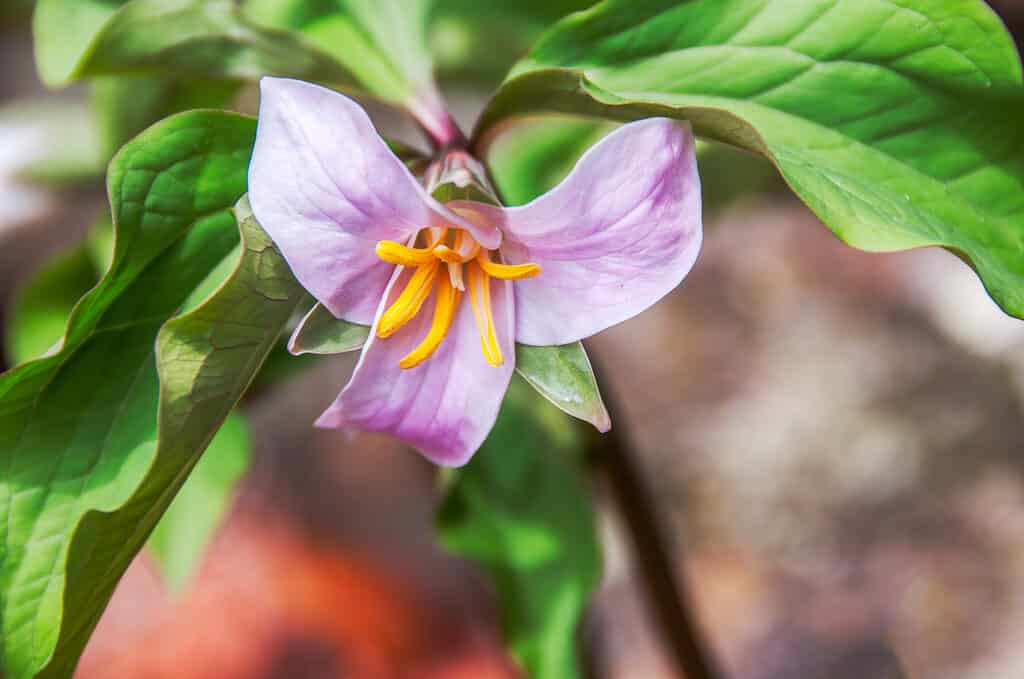
These delicate flowers make beautiful additions to any garden as they provide an attractive display of color that will last for months!
©JayL/Shutterstock.com
A Trillium is a genus of perennial herbaceous flowering plants native to temperate regions in North America and Asia. It typically blooms from late winter until late spring, depending on the species and region. The flower has three petals with white or pink coloration, usually with a yellow or green center area. Its leaves are also arranged in threes, making it easy to identify. It prefers well-drained soil in shaded areas and can be found growing wild along woodland paths or near streams and swamps. These delicate flowers make beautiful additions to any garden as they provide an attractive display of color that will last for months!
11. Winter Aconite

The
flowers are cup-shaped with six petals that open wide in full sun
while remaining closed in the shade.
©PeopleImages.com – Yuri A/Shutterstock.com
Winter aconite (Eranthis hyemalis) is a small tuberous perennial native to Central and Southern Europe. It typically blooms in late winter or early spring, depending on the climate. With its bright yellow flowers and glossy dark green foliage, it’s a welcomed sight after the long winter months! The flowers are cup-shaped with six petals that open wide in full sun while remaining closed in the shade. They have prominent yellow stamens and can reach up to 1 inch across when fully opened. The foliage consists of basal leaves deeply divided into three leaflets standing upright on long stems above the ground. This charming little flower will bring joy to any garden or outdoor space!
Summary of 11 Amazing Early Spring Flowers
- Crocus
- Daffodil
- Dwarf Iris
- Glory of the Snow
- Grape Hyacinth
- Lily of the Valley
- Siberian Squill
- Single Early Tulip
- Snow Drop
- Trillium
- Winter Aconite
The photo featured at the top of this post is © Sergey V Kalyakin/Shutterstock.com
Thank you for reading! Have some feedback for us? Contact the AZ Animals editorial team.






